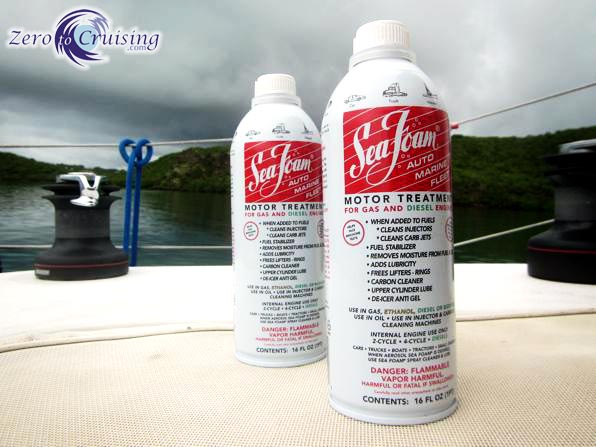Fuel additives voodoo
If you were to look upon the proper shelf in any chandlery or hardware store these days, you’d find a whole selection of products that are designed to be added to your engine’s fuel supply. Some are manufactured specifically for diesel* and others are meant for gasoline. There are other products still which can apparently be added to either. Almost all of them make claims about how they’ll make your engine run like the Six Million Dollar Man: “better…stronger…faster.” In other words, better than it runs without their magical product. But how can you or I, Joe Consumer, really tell if they work?
It all seems pretty subjective to me, especially considering all of the variables. If you add the stuff as advertised and you don’t have problems, you think that it works. If you add it and you have problems, you discount the product’s value. To me, it comes down to trust and not the trust of some Madison Avenue advertising guy but rather someone who I know enjoys doing research on the subject. With that said, while we have used other products in the past, the only stuff we add to our fuel these days is Seafoam. Does it work? As I said, how do you really know? As long as the engines keep working, I’ll say yes.
- Note that we had not been adding Seafoam to our dinghy’s fuel supply. If we had been, perhaps we wouldn’t have had our recent carb issues? 🙂

Don’t take our word on which product to use, if any. We haven’t done the research.
We’re just trusting someone who we know that has.
*Search the blog I linked about diesel additives as our friend Drew has done several studies on those products as well.


Many people on a motorcycle forum I subscribe to swear by this stuff…
Then I assume their engines are working. 🙂
Thanks for the note about the additive. I had not heard of that one.
But, mainly THANK-YOU for NOT putting musak on that video.
That IMHO is how all boat or water videos should be. The relevant noises are what we like.
Yes, I know the yoof are all conditioned to require a loud cacophony with everything. But not all of us are yoofs! 🙂
I have now played that video repeatedly, thanks.
Mike
yoof?
http://www.urbandictionary.com/define.php?term=yoof
Youth of today.
Yes, I had to look that one up! 🙂
Mike Bruce is obviously more of a yoof than we are because he is using words like “yoof” and we haven’t even heard of them. 😉
🙂 🙂
Mike, I am not double your age, but nearer than I care to admit!!!
(Old) Mike !
You have two engines, right? Why not put the SeaFoam in one and not in the other? Then you would have a real-world comparison…
The engines are both fed from the same fuel tank. Not a bad idea though.
Hi Mike,
I can’t find the diesel link… Maybe I’m blind.
There are several posts on his blog relating to diesel. Here is a link to a search which brings them up.
http://sail-delmarva.blogspot.com/search?q=diesel
Note that some of his test results were published in magazines and thus are not available on his site. The one where he directly recommends SeaFoam is among them I think.
For gasoline the 3 best were:
Seafoam
Biobor EB
Mercury Store-n-start
CRC Phase Guard 4 made things worse (emulsions are corrosive). All others helped a little.
Diesel testing has just begun. I’ll post something in a few weeks.
There you have it, from the horse’s mouth.
Awesome, many thanks.
You’re welcome.
A friend once told me a story about fuel additives and a conversation he had with a trusted mechanic.
“So, do these things actually work?” he asked the mechanic.
“Well…do you think they work?” was the answer.
“Well…yeah, I think they work” my friend answered.
“Well, then it is working” answered the mechanic, smiling.
Exactly my point. I do trust my friend’s finding though.
Are fishing lures designed to catch fish or fishermen? I think they sell some of each kind, and I admit I’ve been caught a few times. Now days I find I read catalogs as much for ideas of things to test as for things to buy.
As for misinformation, consider this topic:
http://sail-delmarva.blogspot.com/2012/12/eg-vs-pg-conventional-wisdom-that-is.html
Three months have passed since I sent the core of this post to a number of state agencies and environmental groups; none had other science to offer. Two more months of testing have passed since I wrote the post and none of the findings have changed. Of course, of what interest are glycols to Zero-To-Cruising? I can hear Mike snickering from here (it’s snowing outside). Then again, the skiing was so choise last weekend I’m still grinning.
We may some day go skiing but I guarantee that we won’t be bringing our engines with us. 🙂
Yeah, they are working.
Separating somebody from their money!
Well, as long as they’re working. :p
Hi Mike! Can I assume you only use the high priced marine gasoline in your outboards and not the cheaper auto gasoline with ethanol? Enjoy the site!
Pretty sure that is only a North American issue at present. I don’t THINK that there is any ethanol in fuel down here.
Mike, been making my own for a few years now. Use it in my truck, car and outboard every few tankfuls and also add to crankcase just before an oil change. Here is a link to the recipe;
http://hildstrom.com/projects/seafoam/index.html
So, Sir, need to have a conversation with Drew. I bet you’d get along wonderfully!
Why are you mixing beer with your oil?
IPA? n’yuk n’yuk n’yuk.